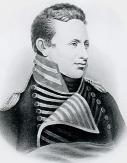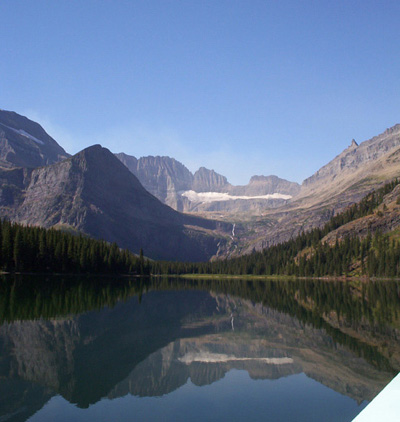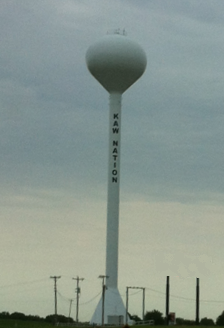|
Guide Rock (hill)
Guide Rock, whose Pawnee name is Pa-hur or Pahur, is a hill in south central Nebraska in the United States. In the traditional Pawnee religion, it was one of five dwelling places of spirit animals with miraculous powers. In 1806, separate expeditions led by Facundo Melgares and Zebulon Pike both journeyed to a large Pawnee village nearby; Pike persuaded the inhabitants to lower the recently received flag of Spain and replace it with that of the United States. The hill's English name was given to the nearby village of Guide Rock, Nebraska. Description Guide Rock is located in Webster County, Nebraska. It lies southeast of the town that bears its name, on the south side of the Republican River and just east of Rankin Creek. Descriptions of the landform vary. The United States Geological Survey classifies it as a "pillar", which it defines as a " rtical, standing, often spire-shaped, natural rock formation". A local writer described it as a "vast rocky bluff".Ohmstede, Bonn ... [...More Info...] [...Related Items...] OR: [Wikipedia] [Google] [Baidu] |
Webster County, Nebraska
Webster County is a county in the U.S. state of Nebraska. As of the 2020 United States Census, the population was 3,411. Its county seat is Red Cloud. The county was formed in 1871, and was named for Daniel Webster. In the Nebraska license plate system, Webster County is represented by the prefix 45 (it had the forty-fifth-largest number of vehicles registered in the county when the license plate system was established in 1922). Geography Webster County lies along the south line of Nebraska. Its south boundary line abuts the north boundary line of the state of Kansas. The terrain of Webster County consists of low rolling hills, sloping to the east. The more planar areas of the county are used for agriculture, mostly under center pivot irrigation. The Republican River flows eastward across the lower part of the county. The county has an area of , of which is land and (0.02%) is water. Major highways * U.S. Highway 136 * U.S. Highway 281 * Nebraska Highway 4 * Nebraska ... [...More Info...] [...Related Items...] OR: [Wikipedia] [Google] [Baidu] |
Cedar River (Nebraska)
{{place name disambiguation ...
Cedar River may refer to: Canada * Cedar River (Ontario), a tributary of the English River United States * Cedar River (Iowa River tributary), in Minnesota and Iowa, a tributary of the Iowa River * Cedar River (Antrim County, Michigan) * Cedar River (Gladwin County, Michigan) * Cedar River (Menominee County, Michigan) * Cedar River (New York), a tributary of the Hudson River * Cedar River (Washington), a tributary of Lake Washington * Cedar River (Willapa Bay), Washington * Cedar Creek (North Dakota), also known as Cedar River See also * Cedar (other) * Cedar Creek (other) * Little Cedar River (other) * Red Cedar River (other) Red Cedar River may refer to the following streams in the United States: * Red Cedar River (Michigan), a tributary of the Grand River * Red Cedar River (Wisconsin), a tributary of the Chippewa River * Cedar River (Iowa River tributary), also known ... [...More Info...] [...Related Items...] OR: [Wikipedia] [Google] [Baidu] |
James Wilkinson
James Wilkinson (March 24, 1757 – December 28, 1825) was an American soldier, politician, and double agent who was associated with several scandals and controversies. He served in the Continental Army during the American Revolutionary War, but he was twice compelled to resign. He was twice the Senior Officer of the U.S. Army, appointed to be the first Governor of the Louisiana Territory in 1805, and commanded two unsuccessful campaigns in the St. Lawrence River theater during the War of 1812. He died while posted as a diplomat in Mexico City. In 1854, following extensive archival research in the Spanish archives in Madrid, Louisiana historian Charles Gayarré exposed Wilkinson as having been a highly paid spy in the service of the Spanish Empire. In the years since Gayarré's research became public, Wilkinson has been savagely condemned by American historians and politicians. According to President Theodore Roosevelt, " all our history, there is no more despicable character ... [...More Info...] [...Related Items...] OR: [Wikipedia] [Google] [Baidu] |
Lewis And Clark Expedition
The Lewis and Clark Expedition, also known as the Corps of Discovery Expedition, was the United States expedition to cross the newly acquired western portion of the country after the Louisiana Purchase. The Corps of Discovery was a select group of U.S. Army and civilian volunteers under the command of Captain Meriwether Lewis and his close friend Second Lieutenant William Clark. Clark and 30 members set out from Camp Dubois, Illinois, on May 14, 1804, met Lewis and ten other members of the group in St. Charles, Missouri, then went up the Missouri River. The expedition crossed the Continental Divide of the Americas near the Lemhi Pass, eventually coming to the Columbia River, and the Pacific Ocean in 1805. The return voyage began on March 23, 1806, at Fort Clatsop, Oregon, and ended on September 23 of the same year. President Thomas Jefferson commissioned the expedition shortly after the Louisiana Purchase in 1803 to explore and to map the newly acquired territory, to find a pr ... [...More Info...] [...Related Items...] OR: [Wikipedia] [Google] [Baidu] |
Santa Fe, New Mexico
Santa Fe ( ; , Spanish for 'Holy Faith'; tew, Oghá P'o'oge, Tewa for 'white shell water place'; tiw, Hulp'ó'ona, label=Tiwa language, Northern Tiwa; nv, Yootó, Navajo for 'bead + water place') is the capital of the U.S. state of New Mexico. The name “Santa Fe” means 'Holy Faith' in Spanish, and the city's full name as founded remains ('The Royal Town of the Holy Faith of Saint Francis of Assisi'). With a population of 87,505 at the 2020 United States census, 2020 census, it is the List of municipalities in New Mexico, fourth-largest city in New Mexico. It is also the county seat of Santa Fe County. Its metropolitan area is part of the Albuquerque, New Mexico, Albuquerque–Santa Fe–Las Vegas, New Mexico, Las Vegas Albuquerque–Santa Fe–Las Vegas combined statistical area, combined statistical area, which had a population of 1,162,523 in 2020. Human settlement dates back thousands of years in the region, the placita was founded in 1610 as the capital of . It replace ... [...More Info...] [...Related Items...] OR: [Wikipedia] [Google] [Baidu] |
Mississippi River
The Mississippi River is the second-longest river and chief river of the second-largest drainage system in North America, second only to the Hudson Bay drainage system. From its traditional source of Lake Itasca in northern Minnesota, it flows generally south for to the Mississippi River Delta in the Gulf of Mexico. With its many tributaries, the Mississippi's watershed drains all or parts of 32 U.S. states and two Canadian provinces between the Rocky and Appalachian mountains. The main stem is entirely within the United States; the total drainage basin is , of which only about one percent is in Canada. The Mississippi ranks as the thirteenth-largest river by discharge in the world. The river either borders or passes through the states of Minnesota, Wisconsin, Iowa, Illinois, Missouri, Kentucky, Tennessee, Arkansas, Mississippi, and Louisiana. Native Americans have lived along the Mississippi River and its tributaries for thousands of years. Most were hunter-ga ... [...More Info...] [...Related Items...] OR: [Wikipedia] [Google] [Baidu] |
Louisiana Territory
The Territory of Louisiana or Louisiana Territory was an organized incorporated territory of the United States that existed from July 4, 1805, until June 4, 1812, when it was renamed the Missouri Territory. The territory was formed out of the District of Louisiana, which consisted of the portion of the Louisiana Purchase north of the 33rd parallel (which is now the Arkansas–Louisiana state line). Background The Eighth Congress of the United States on March 26, 1804, passed legislation entitled "An act erecting Louisiana into two territories, and providing for the temporary government thereof," which established the Territory of Orleans and the District of Louisiana as organized incorporated U.S. territories. With regard to the District of Louisiana, this organic act, which went into effect on October 1, 1804, detailed the authority of the governor and judges of the Indiana Territory to provide temporary civil jurisdiction over the expansive region. Establishment On March ... [...More Info...] [...Related Items...] OR: [Wikipedia] [Google] [Baidu] |
Louisiana Purchase
The Louisiana Purchase (french: Vente de la Louisiane, translation=Sale of Louisiana) was the acquisition of the territory of Louisiana by the United States from the French First Republic in 1803. In return for fifteen million dollars, or approximately eighteen dollars per square mile, the United States nominally acquired a total of in Middle America. However, France only controlled a small fraction of this area, most of which was inhabited by Native Americans; effectively, for the majority of the area, the United States bought the "preemptive" right to obtain "Indian" lands by treaty or by conquest, to the exclusion of other colonial powers. The Kingdom of France had controlled the Louisiana territory from 1699 until it was ceded to Spain in 1762. In 1800, Napoleon, the First Consul of the French Republic, regained ownership of Louisiana as part of a broader effort to re-establish a French colonial empire in North America. However, France's failure to suppress a revol ... [...More Info...] [...Related Items...] OR: [Wikipedia] [Google] [Baidu] |
George Bird Grinnell
George Bird Grinnell (September 20, 1849 – April 11, 1938) was an American anthropologist, historian, naturalist, and writer. Grinnell was born in Brooklyn, New York, and graduated from Yale University with a B.A. in 1870 and a Ph.D. in 1880. Originally specializing in zoology, he became a prominent early conservationist and student of Native American life. Grinnell has been recognized for his influence on public opinion and work on legislation to preserve the American bison. Mount Grinnell in Glacier National Park in Montana is named after Grinnell. Exploration and conservation Grinnell had extensive contact with the terrain, animals and Native Americans of the northern plains, starting with being part of the last great hunt of the Pawnee in 1872. He spent many years studying the natural history of the region. As a graduate student, he accompanied Lieutenant Colonel George Armstrong Custer’s 1874 Black Hills expedition as a naturalist. He declined a similar appointm ... [...More Info...] [...Related Items...] OR: [Wikipedia] [Google] [Baidu] |
Waconda Reservoir
Waconda Lake, also known as Glen Elder Reservoir, is a reservoir in Mitchell County and Osborne County, Kansas, United States. Built and managed by the U.S. Bureau of Reclamation for flood control and irrigation, it is also used for recreation. Glen Elder State Park is located on its north shore. History Prior to the building of Glen Elder Dam, the present-day site of Waconda Lake was the location of Waconda Spring, a natural flowing artesian well, from which the lake was named. To capitalize on it, in 1904 the Cawker City Mineral Company opened a resort on the site of the spring. In 1907, G.F. Abraham of Mankato, Kansas converted the resort into a health spa. Part of the Pick–Sloan Missouri Basin Program authorized by the Flood Control Act of 1944, Glen Elder Dam was one of six units in the Smoky Hill River basin specified as necessary for flood control and irrigation. The U.S. Bureau of Reclamation began purchasing rights-of-way in June 1963 and started constructing th ... [...More Info...] [...Related Items...] OR: [Wikipedia] [Google] [Baidu] |
Waconda Spring
Waconda Spring, or Great Spirit Spring, was a natural artesian spring located in Mitchell County, near the communities of Glen Elder and Cawker City in the U.S. state of Kansas. It was a sacred site for Native American tribes of the Great Plains and, for a time, became the site of a health spa for American settlers. With the completion of the Glen Elder Dam in 1968, the mineral spring was sealed then disappeared beneath the waters of Waconda Reservoir. Description Waconda Spring was situated on the bank of the Solomon River, below the North and South Forks of the river. The water flowing from the spring had deposited a large cone of travertine around it.Buchanan, Rex, Robert Sawin, and Wayne Lebsack (2000)."Water of the Most Excellent Kind: Historic Springs in Kansas". ''Kansas History: A Journal of the Central Plains''. pp. 128-41. Retrieved 2010-09-18. In 1866, surveyor David E. Ballard described it: The Spring itself is a natural , it being located on the summit of ... [...More Info...] [...Related Items...] OR: [Wikipedia] [Google] [Baidu] |
Kaw (tribe)
The Kaw Nation (or Kanza or Kansa) is a federally recognized Native American tribe in Oklahoma and parts of Kansas. It comes from the central Midwestern United States. It has also been called the "People of the South wind","Constitution of the Kaw Nation." ''Kaw Nation.'' 2011. Retrieved 30 April 2012. "People of water", ''Kansa'', ''Kaza'', ''Konza'', ''Conza'', ''Quans'', ''Kosa'', and ''Kasa''. Their tribal language is Kansa, classified as a .Unrau, William [...More Info...] [...Related Items...] OR: [Wikipedia] [Google] [Baidu] |






